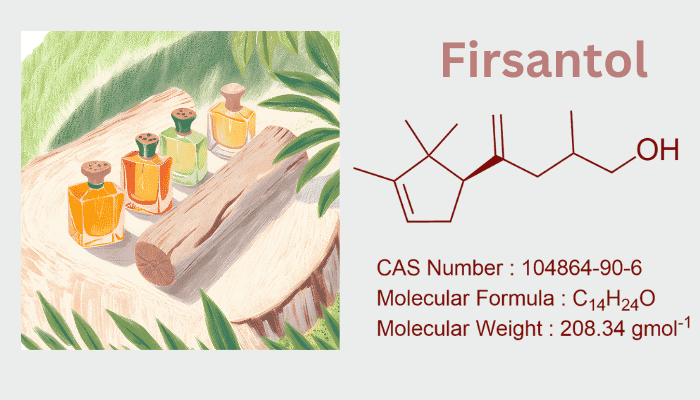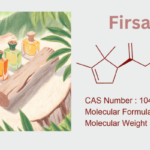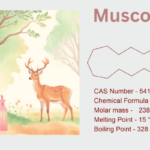1. Introduction: The Emergence of Firsantol in Perfumery
Firsantol has become a fascinating synthetic molecule in the constantly changing field of fragrance chemistry, praised for its capacity to convey the clear, resinous scent of old forests and sunny pine groves. Firsantol, created to satisfy the market for reliable and ecological fragrance ingredients, is the perfect example of how cutting-edge science and nature-inspired design can coexist. By examining Firsantol’s chemistry, production, and uses, this article demonstrates how this contemporary wonder is revolutionizing woody accords in perfumery and other fields.
2. Chemical Identity: Decoding Firsantol’s Molecular Blueprint
A diterpenoid derivative called firsantol (C₁₈H₃₀O₂) was created to mimic the scent of coniferous resins. Important structural elements consist of:
- A bicyclic framework with a hydroxyl (-OH) and acetyloxy (-OAc) functional group.
- Chirality: The (1R,4S) configuration enhances its binding to olfactory receptors.
- Moderate volatility: Boiling point ~280°C, positioning it as a heart-to-base note.
Firsantol is a dependable ally for perfumers in intricate formulations since, in contrast to natural terpenes, its synthetic backbone guarantees durability against oxidation.
3. Synthesis of Firsantol: Bridging Nature and Laboratory
Green catalysis and terpene chemistry are combined in the synthesis of Firsantol, with an emphasis on efficiency and environmental responsibility:
Starting Materials
- α-Pinene: Sourced from pine resin or synthesized via petrochemical routes.
- Isoprenoid Precursors: Building blocks for constructing the diterpenoid skeleton.
Key Reaction Steps
- Epoxidation: α-Pinene undergoes epoxidation using hydrogen peroxide and a tungsten catalyst.
- Cyclization: Acid-catalyzed cyclization (e.g., with Amberlyst-15) forms the bicyclic core.
- Acetylation: The hydroxyl group is acetylated to enhance longevity and solubility in ethanol.
Biotechnological Innovations
- Engineered Bacteria: E. coli modified with terpene synthase genes produces Firsantol precursors from glucose.
- Enzymatic Acetylation: Lipases minimize chemical waste by taking the place of harsh acetylating agents.
Purification
- Distillation: Separates Firsantol from reaction byproducts like camphene.
- Crystallization: Hexane/ethanol mixtures yield >98% purity.
4. Natural Inspiration: The Ghost of Coniferous Forests
While Firsantol is entirely synthetic, its olfactory profile draws inspiration from:
- Pine Resins: Pinus sylvestris contains natural terpenes such as α-pinene and β-phellandrene.
- Balsam Fir: Abies balsamea oleoresin, known for its fresh, green aroma.
Ethical Drivers:
- Deforestation Concerns: Overharvesting of conifers for essential oils.
- Seasonal Variability: Natural resin yields fluctuate with climate and geography.
5. Uses: Beyond the Perfume Bottle
Perfumery
- Heart Note: Anchors fougère and chypre fragrances (e.g., Creed Green Irish Tweed).
- Accord Blending: Complements citrus (bergamot), herbs (lavender), and woods (vetiver).
Cosmetics
- Skincare: Adds antimicrobial properties to natural deodorants.
- Candles and Diffusers: Ensures consistent scent throw in soy wax formulations.
Functional Applications
- Air Fresheners: Mimics “fresh forest” aromas in eco-friendly sprays.
- Textile Softeners: Imparts a clean, outdoor-inspired fragrance to fabrics.
6. Perfume Formulation: The Art of Integrating Firsantol
Role in Fragrance Pyramids
- Balance: enhances earthy base tones (musk, oakmoss) and softens harsh top notes (citrus, for example).
- Fixative Properties: Extends longevity of volatile components like limonene.
Iconic Formulations
- Tom Ford’s Vert des Bois: Firsantol’s resinous greenness enhances its woodland mystique.
- Jo Malone’s Wood Sage & Sea Salt: Adds depth to the mineral-aquatic accord.
Concentration Guidelines
- Fine Fragrances: 0.5–2.0% (e.g., 1.2% in Diptyque Tam Dao).
- Cosmetics: 0.1–0.5% in lotions; IFRA recommends <1% for leave-on products.
7. Challenges and Innovations
Sustainability
- Circular Chemistry: Camphene is one example of a byproduct that is used to make solvents.
- Carbon-Neutral Synthesis: Solar-powered reactors in pilot projects.
Regulatory Compliance
- IFRA/REACH: Rigorous testing for dermal sensitization and biodegradability.
Future Directions
- AI-Driven Blending: Machine learning models predict optimal Firsantol pairings.
- Nanoencapsulation: Silica microspheres control release in slow-diffusion perfumes.
8. Conclusion: Firsantol’s Olfactory Legacy
The sustainable link between old forests and contemporary luxury is provided by Firsantol, which is a monument to the inventiveness of aroma chemistry. As the industry shifts to green innovation and ethical sourcing, its resinous warmth guarantees its place in the perfumer’s palette. The best molecules are those that express a story without using words, according to perfumer Dominique Ropion. Firsantol, with its quiet, evergreen grace, keeps telling stories of science and nature in concord.










